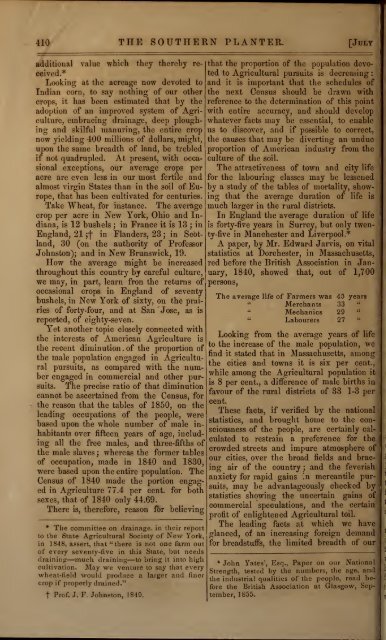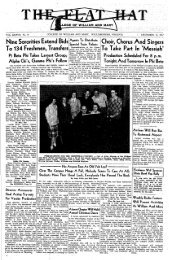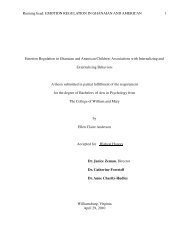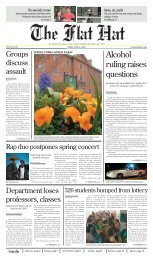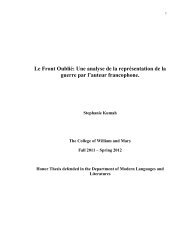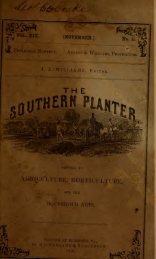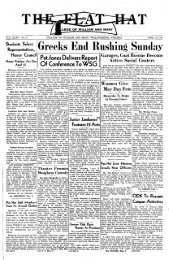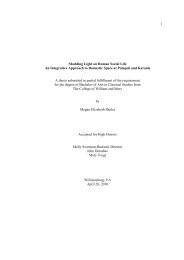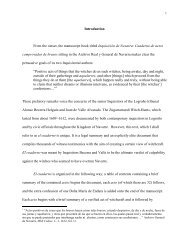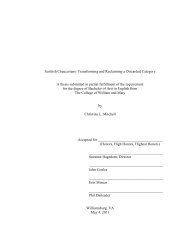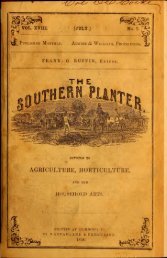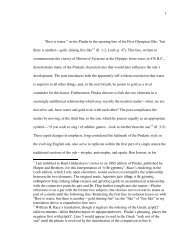Southern planter - The W&M Digital Archive
Southern planter - The W&M Digital Archive
Southern planter - The W&M Digital Archive
Create successful ePaper yourself
Turn your PDF publications into a flip-book with our unique Google optimized e-Paper software.
410 THE SOUTHERN PLANTER. [July<br />
additional value which they thereby re-<br />
ceived.*<br />
Looking at the acreage now devoted to<br />
Indian corn, to say nothing of our other<br />
crops, it lias been estimated that by the<br />
adoption of an improved system of Agriculture,<br />
embracing drainage, deep ploughing<br />
and skilful manuring, the entire crop<br />
now yielding 400 millions of dollars, might,<br />
upon the same breadth of land, be trebled<br />
if not quadrupled. At present, with occasional<br />
exceptions, our average crops per<br />
acre are even less in our most fertile and<br />
almost virgin States than in the soil of Eu-<br />
rope, that has been cultivated for centuries.<br />
Take Wheat, for instance. <strong>The</strong> average<br />
crop per acre in New York, Ohio and In-<br />
diana, is 12 bushels ; in France it is 13 ; in<br />
England, 21 jf<br />
in Flanders, 23 j in Scot-<br />
land, 30 (on the authority of Professor<br />
Johnston); and in New Brunswick, 19.<br />
How the average might be increased<br />
throughout this country by careful culture,<br />
we may, in part, learn fron the returns of<br />
occasional crops in England of seventy<br />
bushels, in New York of sixty, on the prai-<br />
ries of forty-four, and at San Jose, as is<br />
reported, of eighty-seven.<br />
Yet another topic closely connected with<br />
the interests of American Agriculture is<br />
the recent diminution . of the proportion of<br />
the male population engaged in Agricultural<br />
pursuits, as compared with the number<br />
engaged in commercial and other pursuits.<br />
<strong>The</strong> precise ratio of that diminution<br />
cannot be ascertained from the Census, for<br />
the reason that the tables of 1850, on the<br />
leading occupations of the people, were<br />
based upon the whole number of male in-<br />
habitants over fifteen years of age, including<br />
all the free males, and three-fifths of<br />
the male slaves ; whereas the former tables<br />
of occupation, made in 1840 and 1830,<br />
were based upon the entire population. <strong>The</strong><br />
Census of 1840 made the portion engaged<br />
in Agriculture 77.4 per cent, for both<br />
sexes, that of 1840 only 44.69.<br />
<strong>The</strong>re is, therefore, reason for believing<br />
* <strong>The</strong> committee on drainage, in their report<br />
to the State Agricultural Society of New York,<br />
in 1848, assert, that "there is not one farm out<br />
of every seventy-five in this State, but needs<br />
draining—much draining—to bring it into high<br />
cultivation. May we venture to say that every<br />
wheat-field would produce a larger and finer<br />
crop if properly drained."<br />
| Prof. J. F. Johnston, 1849.<br />
that the proportion of the population devoted<br />
to Agricultural pursuits is decreasing<br />
and it is important that the schedules of<br />
the next Census should be drawn with<br />
reference to the determination of this point<br />
with entire accuracy, and should develop<br />
whatever facts may be essential, to enable<br />
us to discover, and if possible to correct,<br />
the causes that may be diverting an undue<br />
proportion of American industry from the<br />
culture of the soil.<br />
<strong>The</strong> attractiveness of town and city life<br />
for the labouring classes may be lessened<br />
by a study of the tables of mortality, showing<br />
that the average duration of life is<br />
much larger in the rural districts.<br />
In England the average duration of life<br />
is forty-five years in Surrey, but only twen-<br />
ty-five in Manchester and Liverpool.*<br />
A paper, by Mr. Edward Jarvis, on vital<br />
statistics at Dorchester, in Massachusetts,<br />
red before the British Association in January,<br />
1840, showed that, out of 1,700<br />
persons,<br />
<strong>The</strong> average life of Farmers was 45 years<br />
" Merchants 33 "<br />
" Mechanics 29 "<br />
" Labourers 27 "<br />
Looking from the average years of life<br />
to the increase of the male population, we<br />
find it stated that in Massachusetts, among<br />
the cities and towns it is six per cent.,<br />
while among the Agricultural population it<br />
is 8 per cent., a difference of male births in<br />
favour of the rural districts of 33 1-3 per<br />
cent.<br />
<strong>The</strong>se facts, if verified by the national<br />
statistics, and brought home to the con-<br />
sciousness of the people, are certainly cal-<br />
culated to restrain a preference for the<br />
crowded streets and impure atmosphere of<br />
our cities, over the broad fields and bracing<br />
air of the country ; and the feverish<br />
anxiety for rapid gains in mercantile pursuits,<br />
may be advantageously checked by<br />
statistics showing the uncertain gains of<br />
commercial speculations, and the certain<br />
profit of enlightened Agricultural toil.<br />
<strong>The</strong> leading facts at which we have<br />
glanced, of an increasing foreign demand<br />
for breadstuffs, the limited breadth of our<br />
* John Yates', Esq., Paper on our National<br />
Strength, tested by the numbers, the age, and<br />
the industrial qualities of the people, read before<br />
the British Association at Glasgow, September,<br />
1855.


